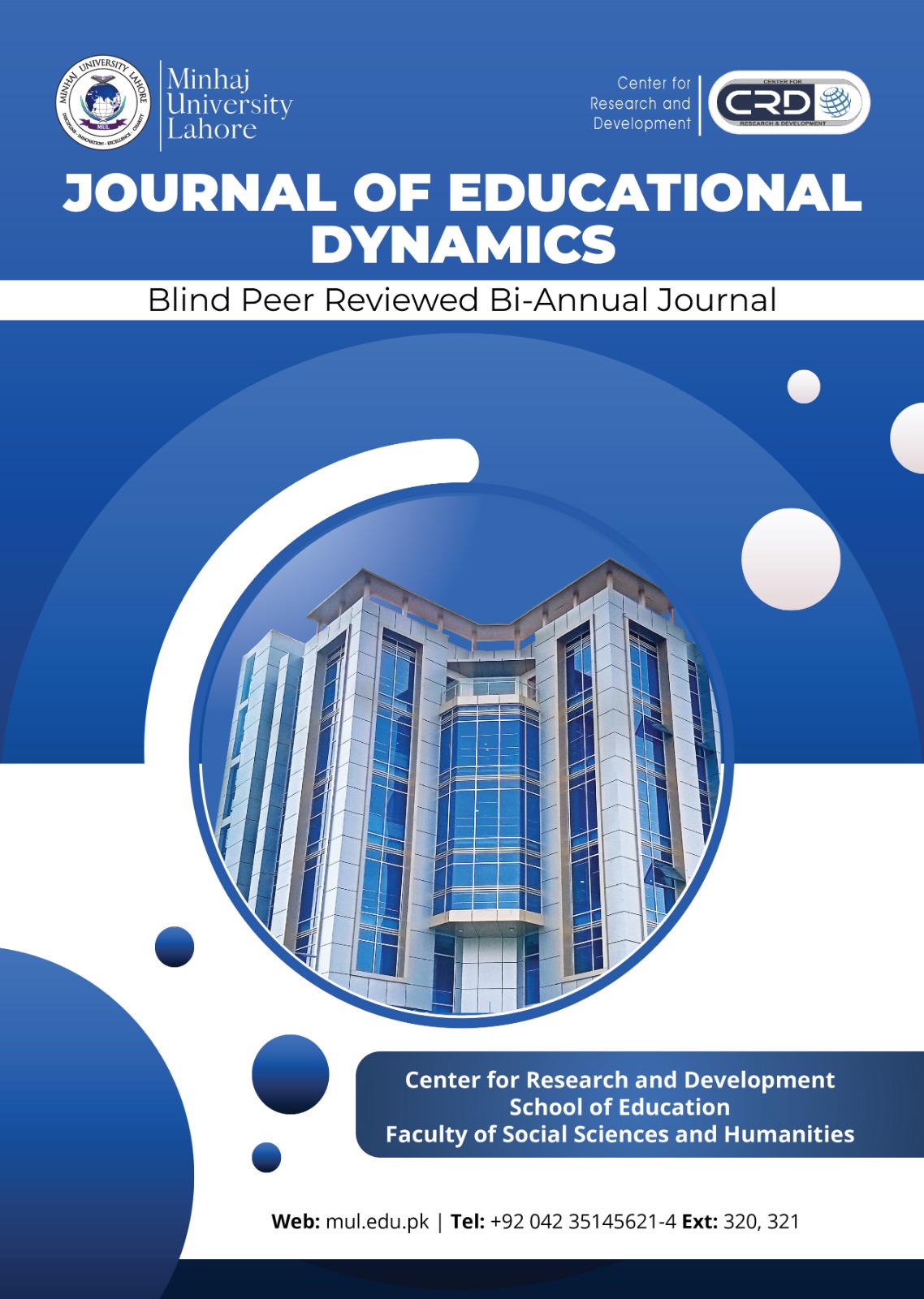The publication division of the Center for Research and Development (CRD) constitutes the third key department, which is primarily responsible for fostering recognition of academic journals by the Higher Education Commission (HEC) of Pakistan, as well as promoting publications in these journals. Additionally, the publication division manages all journals via an online journal system (OJS), ensuring that their publications remain current and readily available to a wider readership. The following activities are closely associated with this division.

AT CRD, the research publications wing, is responsible for developing research infrastructures to facilitate the dissemination of research findings and ensure the quality and integrity of published work. Research infrastructure for journal publications typically includes the following components:
1. Manuscript Submission Systems: These are online platforms where authors can submit their research papers to academic journals. They often include features such as automated formatting checks, manuscript tracking, and communication tools between authors and editors.
2. Peer Review Systems: These systems facilitate the peer review process, which involves the evaluation of submitted manuscripts by experts in the field. They help manage the review workflow, assign reviewers, track reviewer comments, and enable communication between authors, reviewers, and editors.
3. Editorial Management Systems: These systems assist journal editors in overseeing the entire publication process. They handle tasks such as manuscript tracking, communication with authors and reviewers, decision-making on manuscript acceptance or rejection, and managing revisions and final publication.
4. Typesetting and Publishing Tools: Once a manuscript has been accepted, these tools are used to format the article according to the journal`s guidelines. They typically include features for structuring the document, adding figures and tables, managing references, and generating the final PDF or HTML version for publication.
5. Archiving and Indexing Services: Research infrastructure for journal publications often include archiving services that store and preserve published articles for long-term access. Indexing services, such as databases and search engines, ensure that the articles are discoverable and accessible to researchers worldwide.
6. Digital Object Identifiers (DOIs): DOIs are unique identifiers assigned to individual articles, providing a persistent link to their location on the internet. They enable citation and proper attribution of published work and ensure its long-term accessibility.
7. Record Management of journals as required by MUL Authorities and Government Institutions like HEC.
The process of research journal publications involves several important tasks that ensure the quality, integrity, and dissemination of scholarly articles. Here is a general overview of the process and its key tasks:
1. Manuscript Submission: Authors submit their manuscripts to MUL Journals through an online submission system (OJS). They provide the required information, such as author names, affiliations, and contact details, along with the manuscript file. Some journals may also request additional materials like cover letters or supplementary data.
2. Editorial Assessment: The submitted manuscript undergoes an initial editorial assessment. The editor evaluates the manuscript`s suitability for the journal, checks for adherence to guidelines, and ensures ethical compliance. If the manuscript meets the criteria, it proceeds to the next step; otherwise, it may be rejected at this stage.
3. Peer Review: The manuscript is sent to independent experts (peer reviewers) who assess its scientific validity, methodology, interpretation of results, and overall quality. Peer reviewers provide feedback, suggestions, and recommendations to the editor. This process helps ensure the accuracy and credibility of the research.
4. Revision: Based on the feedback received from the peer reviewers and the editor`s decision, authors may be required to revise and improve their manuscript. They address the comments, clarify points, provide additional information if necessary, and make necessary changes to strengthen the article.
5. Acceptance and Copyediting: If the revised manuscript meets the journal`s standards, it is accepted for publication. At this stage, the manuscript undergoes copyediting, where language, grammar, formatting, and style are checked and improved. Authors may be involved in the copyediting process, reviewing and approving the changes made.
6. Proofreading: The final typeset version of the galley proof is sent to the authors. They are required to carefully review the proofs for any remaining errors or issues and provide their final approval before publication.
7. Publication: Once the proofreading stage is completed, the article is published online or in print, depending on the journal`s format. It becomes publicly accessible to the scientific community and readers.
8. Archiving and Indexing: The published article is archived in digital repositories, ensuring long-term preservation and access. CRD allocated DOI to the article as authorized by Crossref. It may also be indexed in databases and search engines, making it discoverable to researchers in the field.
Throughout this process, ethical considerations such as plagiarism, data fabrication, and conflicts of interest are carefully addressed to maintain the integrity of the research and publication.

Al Irfan is a double-blind peer-reviewed journal of Minhaj University, which is published bi-annually. Al-Irfan Research Journal works under (COSIS) College of Shariah and Islamic Sciences, Minhaj University, Lahore, Pakistan. It accepts articles in different languages like Arabic, English, Urdu, etc. This Magazine accepts articles that are written on rare topics such as the Qur'an, Hadith, Fiqh, Seerah, Sufism, Comparison of Religions, History, etc. Al-Irfan Magazine prefers to publish articles that address current issues.

Journal of Basic and Emerging Sciences (JBES) is a peer-reviewed scientific journal and is published by Minhaj University Lahore (MUL). Its primary objective is to provide a platform for the publication of high-quality research articles and to contribute knowledge by publishing innovative and impactful research findings in Basic and Emerging sciences. The journal accepts papers in the fields of Agricultural Sciences, Biophysics, Botany, Chemistry, Entomology and Pest Management, Environmental Sciences, Food Science Technology and Nutrition, Health Sciences, Horticulture, Immunology, Medical Lab.

The journal is designed to welcome research papers of a quality and context that would be of interest to an international readership. The aim and scope of the MJEOS are to provide a venue that reports research on topics that are of national and international significance.
The MJEOS is interdisciplinary and likes to promote original empirical and theoretical research papers including, but not limited to case studies, surveys, discussions of conceptual issues, and book reviews.

The International Journal of Islamic Economics and Governance (IJIEG) is a peer-reviewed journal to disseminate quality research from across the world in the field of economics, business management, commerce, and finance, with an emphasis on the Islamic perspective. IJIEG is sponsored and published by the International Center for Research in Islamic Economics (ICRIE) and the School of Islamic Economics Banking and Finance, Minhaj University, Lahore, Pakistan.

J-NESS is an interdisciplinary academic pursuit to disseminate awareness and information on the importance of our aquatic channels and resources. The purpose of this effort is to bring attention to the latest topics of discussion at the international level, e.g. Sustainable Development of Coastal Indigenous Communities, Blue Economy, Maritime Security and Surveillance, Circular Economy, Marine Renewable Energy, Maritime Transport and Coastal Tourism, Fisheries and Aquaculture, and related geopolitical and geo-economic dimensions.

JPRSS is a collective effort. Our team members aim to synergize their potential and efforts to create a multi-disciplinary, productive, and inclusive international academic fraternity at Minhaj University Lahore. Moving forward with a pro-student approach, we consider students and young scholars as our primary assets and important target audience.

Respectful and critical discussion of issues related to religion and philosophy will lead to a deeper appreciation and understanding of different religions worldwide and promote peace among people.

The Journal of Educational Dynamics (JED) is a prestigious research journal that offers an open-access platform for scholars, educators, professionals, and students worldwide to contribute and exchange valuable insights. Published biannually in June and December by the School of Education at the Faculty of Social Sciences and Humanities at Minhaj University Lahore, Pakistan, JED serves as a reputable forum for disseminating high-quality empirical and theoretical research papers, case studies, literature reviews, and book reviews.

The journal aims to provide a platform for cutting-edge research in corpus linguistics and its applications across various disciplines.
To foster innovation and collaboration in corpus linguistics and related fields by providing a high-quality platform for research dissemination and knowledge sharing.
To establish Minhaj University as a leading institution for advancing corpus-based research and promoting the integration of computational tools in linguistic studies.
The Journal of Biomolecular Sciences is a scholarly platform dedicated to advancing the understanding and knowledge within the realm of biomolecular sciences. This journal serves as a conduit for the dissemination of cutting-edge research and contributions from the scientific community.

ZORAIZ is a peer-reviewed journal to disseminate quality research from across the world in the field of Social Sciences, particularly the Urdu language, with an emphasis on the Islamic perspective. Zoraiz, sponsored and published by the Center for Research and Development at Minhaj University Lahore, Pakistan.